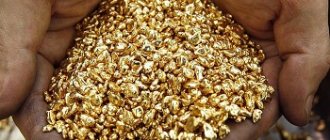List of largest copper producers 2022
Copper production at the top 10 miners is estimated to grow nearly 3.8% in 2022. The
world's largest producer last year was the Escondida mine, located in Chile's arid northern Atacama Desert. The mining complex, jointly owned by BHP, Rio Tinto, Mitsubhishi and JX Nippon, produced 1,173 thousand tonnes of copper in 2020. This is comparable to the production volume, which in 2019 amounted to 1,157 thousand tons.
In second place was the Collahuasi copper mine in northern Chile. The mine's annual copper production, which came online in 1999, was 629 thousand tonnes, up from 565 thousand tonnes the previous year.
According to the latest mine development plan, the mine life will be until 2070. At the same time, the Morenci quarry complex in Greenlee County, Arizona, took third place on the list, producing 450 thousand tons in 2022. It should be noted that the mine produced 460 thousand tons in 2019.
Other copper mines in the top ten along with their production in thousands of tons are as follows: El Teniente, Chile (443), Buenavista, Mexico (432), KGHM Polska Miedz, Poland (413), Chuquicamata, Chile (401), Cerro Verde, Peru (391), Antamina, Peru (367) and Grasberg, Indonesia (367).
It should be noted that the Los Pelambres mine near Santiago, Chile, and the Polar Division mine complex located on the Taimyr Peninsula did not make the top ten list in 2020.
Source
New Russian reserves
The total increase in domestic copper reserves of categories A + B + C1 based on the results of geological exploration (geological exploration) in 2015 amounted to 2.05 million tons, which was more than double their redemption during mining, according to the state report of the Ministry of Natural Resources. About half was at the Tominskoye deposit in the Chelyabinsk region, where, as a result of geological exploration carried out in 2012-2013 by the Russian Drilling Company under an agreement with the Tominsky Mining and Processing Plant, copper reserves of categories B + C1 were increased on the flanks and deep horizons in the amount of 463 thousand tons, C2 — 625.5 thousand tons.
Fundamental Analysis of Copper
Copper is one of the metals that is traded on financial markets. Copper is widely used in production and finds application in the following areas (the share of copper currently directed to these areas is indicated in brackets): 1. Construction (43%). 2. Electric power (20%) 3. Transport (20%). 4. Basic consumer goods (10%). 5. Production equipment (7%).
To fairly assess the cost of copper, it is necessary to consider factors affecting supply and demand, mining and consumption.
Copper production and its global reserves for 2022 according to the United States Geological Survey are as follows:
According to these data, global copper reserves will last for 42.89 years with demand at 2022 levels. The estimated amount of unmined copper on Earth is estimated at around 3 billion tons.
CONSUMPTION.
The main consumer of copper at the moment is China, which consumes about half of all copper produced. Interesting dynamics are observed in the field of transport. If before 2019, about 13% of all mined copper was spent on transport, then in 2019 this number was already 20% and will continue to grow, which is associated with an increase in the production of passenger electric vehicles, which require more copper than conventional cars and, according to estimates a number of experts from the International Copper Association, this could increase copper consumption in the transport sector to 8 million tons per year by 2030 (from 4 million tons per year in 2022). Electric vehicles, power generation and construction will increase demand for copper by 415,000 tons annually.
HISTORICAL PRICES.
Average copper prices and production volumes for the previous five years are shown in the following table:
CONSEQUENCES OF LOCKDOWN.
The lockdown led to a decrease in copper production by large producers and a reduction in investment in new projects. According to Refinitiv data, copper production over the next five years will average 2.2% of earlier forecasts, resulting in an overall decline in supply of 3 million tons of copper over that time period, for an average of 23 million tons per year.
IS IT POSSIBLE TO COPPER DEFICIENCY?
It should be noted that back in 2022, the issue of copper deficiency became acute. According to the statements of the General Director of the Ural Mining and Metallurgical Company Evgeny Bragin, in 2020-2024 there will be an increase in copper consumption by 415,000 tons annually; construction, electric power and the automotive industry (electric vehicles) will stimulate the growth of copper consumption. And given the fact that there are still enough copper reserves in the world, investments in geological exploration become unreasonable, expensive and risky, with the return on risk at copper prices above $10,000 per ton. And in existing deposits, ore depletion is observed. According to the company’s fears, a copper shortage may begin to be felt as early as 2022, and given the lockdown and a decrease in copper production, this date is postponed to 2023-2024.
COPPER RECYCLING.
Recycling of copper. The cost of producing one ton of refined copper from scrap and waste is on average 35% lower than the cost of its production from ore raw materials. In the United States, copper recycled from waste accounts for about 12% of that mined from ore. In Europe this share reaches 50%. In world production this share is 29%. Taking into account the fact that copper can be recycled with very minor losses in its properties, there is wide scope for the development of the processing sector.
WEAKENING DOLLAR.
During 2022, the US dollar is undergoing a significant weakening and is expected to weaken significantly when the QE program is wound down, and sooner or later it will be wound down, it’s only a matter of time. This factor will play in favor of an increase in the price of copper, especially given the fact that in conditions of economic instability, investors seek to place their funds in those assets that will be least susceptible to depreciation. Precious metals are too expensive for these purposes and do not play as significant a role in production as copper, making it one of the most reliable defensive assets.
RUSSIAN COPPER PRODUCERS.
In a small digression, I would like to point out the main copper producers in Russia, there are three of them: 1. Norilsk Nickel (ticket on the Moscow Exchange: GMKN ). 2. Ural Mining and Metallurgical Company (the company is not currently listed on the stock exchange, its subsidiaries were previously available). 3. Russian copper company (the company is not currently listed on the stock exchange). Norilsk Nickel produces about 42% of total production in Russia, UMMC - about 40%, RMK - about 18%. Together, these three companies smelt about 1 million tons annually, of which up to 800 thousand tons are exported. So if you invest not in copper itself, but in a mining company, then among Russian assets only Norilsk Nickel is available, whose performance indicators are slightly beyond the scope of this analysis.
CONCLUSIONS BASED ON THE ABOVE DATA.
Based on historical data, we can say with a high degree of confidence that the minimum copper price level is now $6,000 per ton, which is the average copper price over the previous five years, taking into account inflation and excluding increased demand for it and the current weakening of the dollar. Given the increase in demand and the high cost of geological exploration, it is safe to say that $10,000 per tonne is the long-term growth target for copper over the next five years. Once this goal is achieved, copper recycling will become highly profitable, and the development of new deposits will be more interesting from an investment point of view, which will restrain further growth in the cost of copper.
Bauxite ore is the basis of global aluminum production
The silver metal itself is directly obtained from alumina. This raw material is aluminum oxide (Al2O3), obtained from ores:
- Bauxite;
- Alunitov;
- Nepheline syenites.
The most common source of starting material is bauxite, which is considered the main aluminum ore.
Despite the more than 130-year history of discovery, it has still not been possible to understand the origin of aluminum ore. It is possible that simply in each region the raw materials were formed under the influence of certain conditions. And this makes it difficult to derive one universal theory about the formation of bauxite. There are three main hypotheses about the origin of aluminum raw materials:
- They were formed due to the dissolution of certain types of limestone as a residual product.
- Bauxite was obtained as a result of weathering of ancient rocks with their further transport and deposition.
- The ore is the result of chemical processes of decomposition of iron, aluminum and titanium salts, and fell as sediment.
However, alunite and nepheline ores were formed under different conditions from bauxite. The former were formed under conditions of active hydrothermal and volcanic activity. The second - at high temperatures of magma.
Bauxite
As a result, alunites generally have a crumbly porous structure. They contain up to 40% of various aluminum oxide compounds. But, in addition to the aluminum-bearing ore itself, the deposits, as a rule, contain additives, which affects the profitability of their mining. It is considered profitable to develop a deposit with a 50 percent ratio of alunites to additives.
Nephelines are usually represented by crystalline samples, which, in addition to aluminum oxide, contain additives in the form of various impurities. Depending on the composition, this type of ore is classified into types. The richest contain up to 90% nephelines, second-rate 40-50%; if the minerals are poorer than these indicators, then it is not considered necessary to develop them.
Having an idea of the origin of minerals, geological exploration can quite accurately determine the location of aluminum ore deposits. Also, the formation conditions, which influence the composition and structure of minerals, determine the extraction methods. If the deposit is considered profitable, its development is established.
TOP 10 leading countries in the world of copper producers
The metal received its Latin name Cuprum due to its location on the island of Cyprus. Most of it is found in soil (mines) than in water. Element 29 of the periodic table is found, both in pure form and with impurities.
Poland
Perhaps in 2022 Poland will break all production records in history. In 2022, huge deposits of the fossil were discovered. So far, according to analytical data, Poland refined 630 thousand tons of copper ore last year.
Japan
According to Bloomberg, copper production has fallen sharply. Such trends were noticed due to the exhaustion of mines. The material that can be obtained is of poor quality. State investment in such projects will lead to an increase in prices for fossil fuels. According to agency statistics, only 740 thousand tons were smelted in Japan in 2022.
Canada
Canada is one of the countries with the largest amount of non-ferrous metal deposits in the world. This feature is observed due to the peculiar tectonic location of the territory of the state. Despite the large number of reserves, Canada cannot boast of high numbers due to the presence of ore deep underground. It takes a long time to obtain copper ore and process it. At the same time, the quality of ore is getting worse every year. Last year, 890 thousand tons were produced.
Russia
According to the deputy director of the Ural Metallurgical Company, 2019-2021 may become the starting point for a shortage of minerals in the world. This announcement was made due to the increasing need for copper in the electricity and automotive industries. The production of environmentally friendly cars requires several times more material than the production of conventional vehicles. Last year, 920 thousand tons of minerals were mined in Russia.
South Korea
Over the past 20 years, South Korea has seen changes in the non-ferrous metals industry. Today, some industries are gradually moving to a fully automatic process for processing copper ore. Now, instead of 20 workers, only two mechanization supervisors are needed. In 2022, South Korea produced 1.3 million tons of fossil fuels.
USA
According to analysts at Dow Jones, the United States invests more money in the development of the non-ferrous industry than in the extraction of precious metals. Since the demand for copper is growing every year. It is expected that the cost of the fossil will increase in 2022. Last year, 1.9 million tons were produced in the United States.
Peru
The indigenous population of Peru again staged protests in the first quarter of 2022 over the export of copper outside the state. For several months, factories practically did not work, which will most likely affect the statistics at the end of 2022. According to analysts at Morgan Stanley, 2.4 million tons of minerals were produced in 2022.
India
According to analysts, copper production in India in 2022 will reach about 2.1 million tons. In 2022, the figures were equal to 2.6 million tons. Every year, the need for the use of copper increases in various industries in India. Over the past few years, the need has doubled. Thanks to new infrastructure projects, according to the director of the Indian company Birla Copper, Jagdish Chandra Laddha, the plants will be able to produce the required amount of metal.
China
According to the National Bureau of Statistics of China, last year showed strong results for domestic production. Thanks to this, the need to purchase metal from other countries has decreased. According to general estimates of the PRC, 3.1 million tons were produced.
Chile
6.2 million tons of copper were obtained by ore processing. This is slightly more than ¼ of the world's global production. Due to the strike of some Chilean factories and the flooding of some mines, production figures fell slightly.
Source
Applications of Aluminum Ore
Basically, up to 60% of ore raw materials are used to produce aluminum. However, the rich composition makes it possible to extract from it other chemical elements: titanium, chromium, vanadium and other non-ferrous metals, which are necessary primarily as alloying additives to improve the quality of steel.
As mentioned above, the technological chain for producing aluminum necessarily passes through the stage of formation of alumina, which is also used as fluxes in ferrous metallurgy.
The rich composition of elements in aluminum ore is also used to produce mineral paint. Also, the smelting method produces alumina cement - a quickly hardening, strong mass.
Another material obtained from bauxite is electrocorundum. It is obtained by smelting ore in electric furnaces. It is a very hard substance, second only to diamond, making it popular as an abrasive.
Also, in the process of obtaining pure metal, waste is formed - red mud. The element scandium is extracted from it, which is used in the production of aluminum-scandium alloys, which are in demand in the automotive industry, rocket science, production of electric drives, and sports equipment.
review
In 2022, global copper production was 20.4 million tonnes (2017: 20.0 million tonnes). By far the largest producing country was Chile (5.8 million tons), followed by Peru (2.4 million tons), People's Republic of China (1.6 million tons), USA (1.2 million tons) and DR Congo . (1.2 million tons). The share of these five countries in world production was 60.3%. In Europe, mention should be made of Russia, Poland, Bulgaria, Portugal and Sweden.
Copper smelting and refining is only partially carried out in the respective producing countries. In particular, China now smelts and refines a significant portion of the world's copper production. The following table provides an overview of the four countries with the largest volumes of refined copper.
Figures in millions of tons
| classify | a country | Funding (2017) | Melting (2016) | Recycling (2016) | |
| 1. | People's Republic of China People's Republic of China | 1,7 | 5.5 | 8.0 | |
| 2. | Chile Chile | 5.5 | 1.5 | 2,7 | |
| 3. | Japan Japan | USA USA | 1.3 | 0,5 | 1.2 |
Suitable reserves were estimated by the United States Geological Survey (USGS) in January 2022 at 870 million tons worldwide. Chile accounts for 200 million tons, Australia 87 million tons, Peru also 87 million tons, Russia 61 million tons and Mexico 53 million tons. These five countries together accounted for 56.1 percent of the world's reserves. The range of static reserves is approximately 43 years.
Copper mines on the Keweenaw Peninsula of Lake Superior/USA were historically significant (the world's largest deposit of native copper; mining dates back to pre-Columbian times). In Germany, copper slate was mined in the Mansfeld area until 1990.
Consumption
The high electrical conductivity, thermal conductivity, ductility and corrosion resistance of copper have led to a high level of its use in various fields of industry. Up to three quarters of all refined copper produced in the world is used in the production of electrical conductors, including various types of cables and wires. The main sectors of copper consumption are construction, production of electrical and electronic products, power generation, transport, mechanical engineering, production of various equipment and consumer goods.
In 2022, global consumption of refined copper amounted to 23.7 million tons, an increase of 3%, or 0.7 million tons, compared to 2017, mainly due to increased demand in the production of cable and wire products. The use of copper in the production of pipes, flat products and billets increased slightly.
China remains the world's main consumer of copper, whose share in 2022, due to a 5% increase in consumption, increased to 49%. Experts’ fears about the slowdown in the country’s economic growth (including as a result of the trade war with the United States) were not justified; China continued to increase imports of refined copper and copper concentrates for its production. Imports of refined copper into the country in 2022 increased by 13% and amounted to 5.3 million tons, compensating for a third drop in imports of copper scrap after the government introduced environmental restrictions on it. Imports of copper concentrates increased by 14% to 19.7 million tons, which made it possible to meet growing consumption by increasing its own production capacity.
Demand for copper in developed countries was characterized by moderate growth: in Europe (the main sales region for the Company’s copper cathode) consumption increased by 1.7% in 2022, in North America (after low figures in 2022) by 3.2%, in Asia (except for China) - remained at the same level. Copper cathode consumption in the Russian Federation decreased slightly in 2022.
Demand for copper in developed countries showed moderate growth
Reserves
The USGS distinguishes the following two categories:
- A reserve base is that portion of an identified resource that meets specific minimum physical and chemical criteria for current extraction and production methods, including grade, quality, thickness and depth. Publication of data on the storage base was stopped by the USGS in 2009.
- Inventories are that portion of the supply base that can be economically produced or produced at a given time. This term does not necessarily mean that the exhaust systems are installed and operating. Reserves contain only substances suitable for use.
promotion
Around the country
The following table shows all countries whose annual production in 2022 was more than 10,000 tons. The copper content in ores and concentrates is given. Copper has not been mined in Germany since the early 1990s. All figures refer to states within their current borders.
Figures in thousands of tons
| Rank (2018) | a country | 1970 | 1980 | 1990 | 2000 | 2010 | 2015 | 2016 | 2017 | 2018 |
| 1. | Chile Chile | 686 | 1,068 | 1,588 | 4 602 | 5 419 | 5772 | 5,553 | 5 504 | 5 832 |
| 2. | Peru Peru | 220 | 367 | 323 | 554 | 1,247 | 1,701 | 2354 | 2,446 | 2,437 |
| 3. | People's Republic of China People's Republic of China | 120 | 165 | 285 | 889 | 1,156 | 1,712 | 1 900 | 1,706 | 1,591 |
| 4th | USA USA | 1,560 | 1,181 | 1,588 | 1,444 | 1,110 | 1,416 | 1,462 | 1,290 | 1,250 |
| 5. | Democratic Republic of the Congo DR Congo | 386 | 462 | 352 | 33 | 378 | 1,039 | 1,024 | 1,095 | 1,225 |
| Sixth | Australia Australia | 158 | 244 | 330 | 832 | 871 | 996 | 948 | 849 | 913 |
| 7th | Zambia Zambia | 684 | 610 | 546 | 249 | 767 | 711 | 725 | 797 | 851 |
| 8th. | Russia, Russia | 387 | 400 | 643 | 530 | 703 | 711 | 702 | 762 | 785 |
| 9. | Mexico Mexico | 61 | 175 | 299 | 365 | 270 | 594 | 766 | 742 | 697 |
| 10. | Indonesia Indonesia | 59 | 162 | 1.012 | 863 | 579 | 728 | 622 | 651 | |
| 11. | Kazakhstan Kazakhstan | 138 | 143 | 230 | 430 | 381 | 474 | 475 | 558 | 636 |
| 12th | Canada Canada | 610 | 716 | 794 | 634 | 522 | 715 | 693 | 597 | 539 |
| 13th | Mongolia Mongolia | 44 year | 124 | 126 | 128 | 318 | 516 | 475 | 459 | |
| 14th | Poland Poland | 83 | 343 | 370 | 454 | 426 | 426 | 424 | 419 | 401 |
| 15th | Brazil Brazil | 4th | 34 | 32 | 214 | 359 | 338 | 385 | 381 | |
| 16. | Iran Iran | 1 | 67 | 147 | 257 | 246 | 289 | 296 | 317 | |
| 17th | Spain Spain | 10 | 49 | 13th | 25th | 54 | 113 | 168 | 198 | 185 |
| 18th | Myanmar Myanmar | 10 | 71 | 95 | 116 | 154 | ||||
| 19th | Laos Laos | 132 | 168 | 178 | 153 | 147 | ||||
| 20th | Bulgaria Bulgaria | 42 | 62 | 33 | 93 | 113 | 112 | 110 | 109 | 109 |
| 21st | Sweden Sweden | 26th | 43 years old | 74 | 78 | 77 | 75 | 79 | 104 | 106 |
| 22nd | Uzbekistan Uzbekistan | 42 | 43 years old | 69 | 70 | 80 | 100 | 100 | 100 | 100 |
| 23 | Papua New Guinea Papua New Guinea | 147 | 170 | 203 | 160 | 45 | 80 | 105 | 96 | |
| 24 | Armenia Armenia | 1 | 1 | 1 | 12th | 31 year | 84 | 103 | 114 | 84 |
| 25th | turkey turkey | 31 year | 21 years old | 40 | 76 | 80 | 108 | 100 | 83 | 80 |
| 26th | Philippines Philippines | 160 | 305 | 181 | 32 | 58 | 84 | 84 | 68 | 70 |
| 27 | Saudi Arabia Saudi Arabia | 2 | 12th | 28 | 36 | 68 | ||||
| 28. | Portugal Portugal | 4th | 4th | 160 | 76 | 74 | 83 | 74 | 64 | 49 |
| 29 | South Africa South Africa | 144 | 201 | 188 | 148 | 103 | 77 | 65 | 66 | 47 |
| 30's | Finland Finland | 31 year | 53 | 18th | 12th | 15th | 41 years old | 47 | 53 | 47 |
| 31. | Serbia Serbia | 85 | 107 | 129 | 46 | 23 | 30's | 41 years old | 45 | 44 year |
| 32. | India India | 10 | 27 | 52 | 38 | 32 | 32 | 32 | 34 | 37 |
| 33. | Mauritania Mauritania | 37 | 45 | 33 | 29 | 28 | ||||
| 34. | Morocco Morocco | 15th | 20th | 24 | 25th | 24 | ||||
| 35. | Vietnam Vietnam | 12th | 23 | 23 | 21 years old | 23 | ||||
| 36. | Argentina Argentina | 1 | 145 | 140 | 62 | 82 | 33 | 17th | ||
| 37. | Eritrea Eritrea | 62 | 25th | 8th | 17th | |||||
| 38. | Pakistan Pakistan | 20th | 16 | 14th | 15th | 17th | ||||
| 39. | Namibia Namibia | 23 | 39 | 28 | 5 | 14th | 17th | 16 | 15th | |
| 40. | Georgia Georgia | 3 | 3 | 4th | 9 | 11 | 13th | 14th | 15th | 13th |
| 41. | Colombia Colombia | 2 | 1 | 5 | 8th | 9 | 10 |
By company
The company, the country in which it is located, the volume of production and the share of world production are listed.
Figures in thousands of tons (2017)
| classify | Companies | a country | quantity | Ownership % |
| 1. | Codelco | Chile Chile | 1840 | 9.1 |
| 2. | Freeport-McMoRan | USA USA | 1436 | 7.1 |
| 3. | Glencore | Switzerland Switzerland | 1247 | 6.2 |
| 4th | Grupo Mexico | Mexico Mexico | 883 | 4.4 |
| 5. | BHP Billiton | Australia Australia United Kingdom United Kingdom | 796 | 3.9 |
| Sixth | KGHM Polska Mied | Poland Poland | 553 | 2,7 |
| 7th | The first quantum minerals | Canada Canada | 513 | 2,5 |
| 8th. | Rio Tinto Group | Australia Australia United Kingdom United Kingdom | 499 | 2,5 |
| 9. | Antofagasta plc | United Kingdom United Kingdom | 486 | 2.4 |
| 10. | Group of Minerals and Metals | Australia Australia | 445 | 2.2 |
Global funding
The following table shows global production in thousands of tons.
Figures in thousands of tons
| 495 | |
| 1901 | 526 |
| 1902 | 555 |
| 1903 | 596 |
| 1904 | 660 |
| 1905 | 713 |
| 1906 | 724 |
| 1907 | 721 |
| 1908 | 744 |
| 1909 | 828 |
| 1910 | 858 |
| 1911 | 890 |
| 1912 | 1,000 |
| 1913 | 996 |
| 1914 | 938 |
| 1,060 | |
| 1916 | 1,420 |
| 1917 | 1,430 |
| 1918 | 1,430 |
| 1919 | 994 |
| 1920 | 959 |
| 1921 | 558 |
| 1922 | 884 |
| 1923 | 1,270 |
| 1924 | 1,360 |
| 1925 | 1,530 |
| 1926 | 1,510 |
| 1927 | 1,520 |
| 1928 | 1,730 |
| 1929 | 1,950 |
| 1,610 | |
| 1931 | 1,400 |
| 1932 | 909 |
| 1933 | 1,050 |
| 1934 | 1,280 |
| 1935 | 1,500 |
| 1936 | 1,720 |
| 1937 | 2290 |
| 1938 | 1,990 |
| 1939 | 2,130 |
| 1940 | 2400 |
| 1941 | 2,480 |
| 1942 | 2,590 |
| 1943 | 2 620 |
| 1944 | 2,460 |
| 2,110 | |
| 1946 | 1,780 |
| 1947 | 2,130 |
| 1948 | 2,210 |
| 1949 | 2,140 |
| 1950 | 2380 |
| 1951 | 2,490 |
| 1952 | 2,570 |
| 1953 | 2600 |
| 1954 | 2640 |
| 1955 | 2 900 |
| 1956 | 3 200 |
| 1957 | 3 300 |
| 1958 | 3 190 |
| 1959 | 3 430 |
| 3 940 | |
| 1961 | 4 090 |
| 1962 | 4220 |
| 1963 | 4290 |
| 1964 | 4 450 |
| 1965 | 4 660 |
| 1966 | 4,580 |
| 1967 | 4 630 |
| 1968 | 5,010 |
| 1969 | 5 520 |
| 1970 | 5 900 |
| 1971 | 5 940 |
| 1972 | 6 540 |
| 1973 | 6 920 |
| 1974 | 7 100 |
| 6 740 | |
| 1976 | 7 260 |
| 1977 | 7 420 |
| 1978 | 7 280 |
| 1979 | 7,350 |
| 1980 | 7 200 |
| 1981 | 7 690 |
| 1982 | 7 580 |
| 1983 | 7 610 |
| 1984 | 7 810 |
| 1985 | 7 990 |
| 1986 | 7 940 |
| 1987 | 8 240 |
| 1988 | 8 720 |
| 1989 | 9 040 |
| 9 200 | |
| 1991 | 9 330 |
| 1992 | 9 470 |
| 1993 | 9 490 |
| 1994 | 9 500 |
| 1995 | 10 000 |
| 1996 | 11 000 |
| 1997 | 11 500 |
| 1998 | 12 100 |
| 1999 | 12 800 |
| 2000 | 13 200 |
| 2001 | 13 700 |
| 2002 | 13 600 |
| 2003 | 13 800 |
| 2004 | 14 700 |
| 2006 | 15 100 |
| 2007 | 15 500 |
| 2008 | 15 600 |
| 2009 | 16 000 |
| 2010 | 16 100 |
| 2011 | 16 300 |
| 2012 | 16 900 |
| 2013 | 18 300 |
| 2014 | 18 500 |
| 2015 | 19 100 |
| 2016 | 20 100 |
| 2017 | 20 000 |
| 2018 | 20 400 |
| 2019 e | 20 000 |









